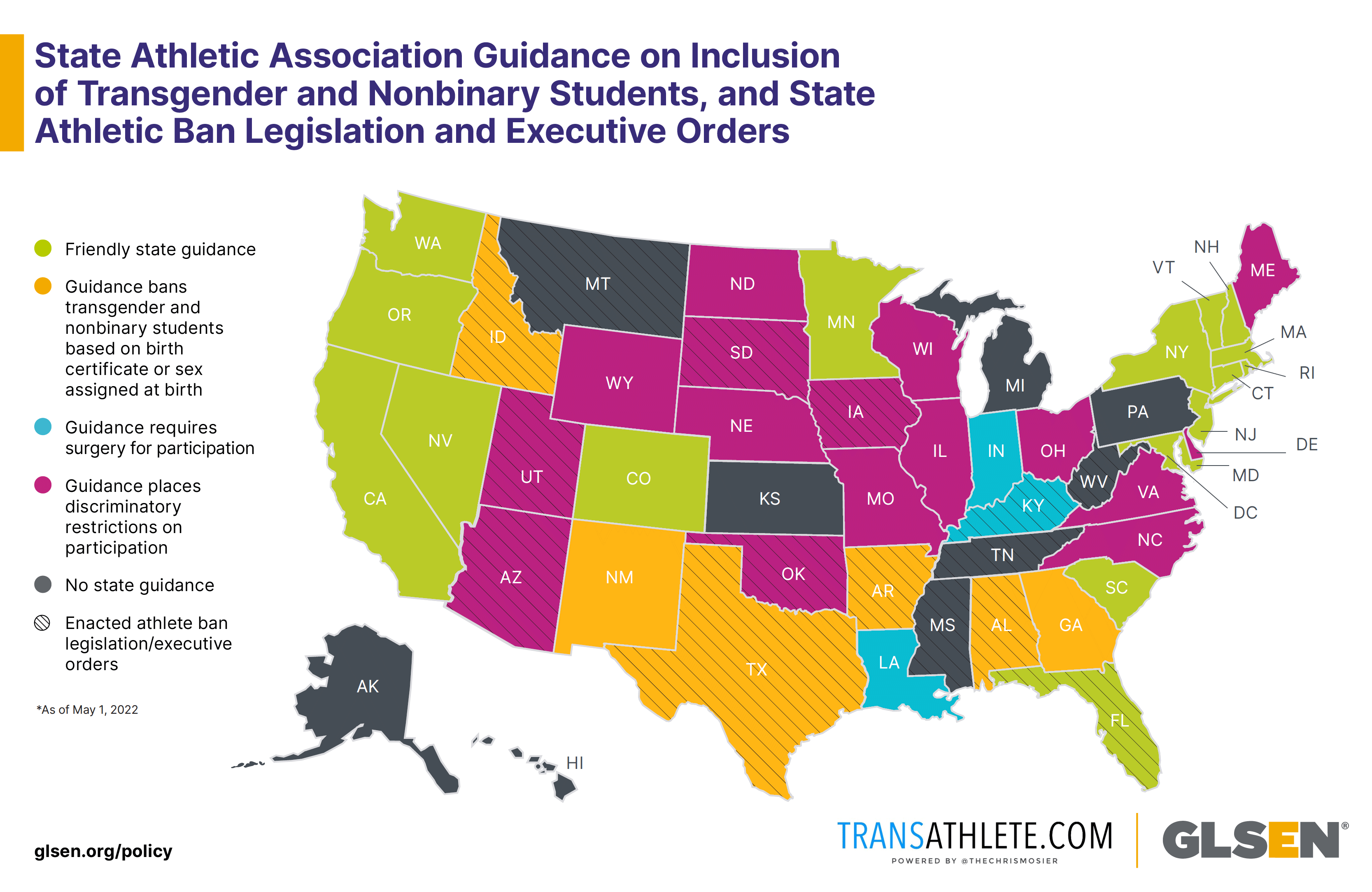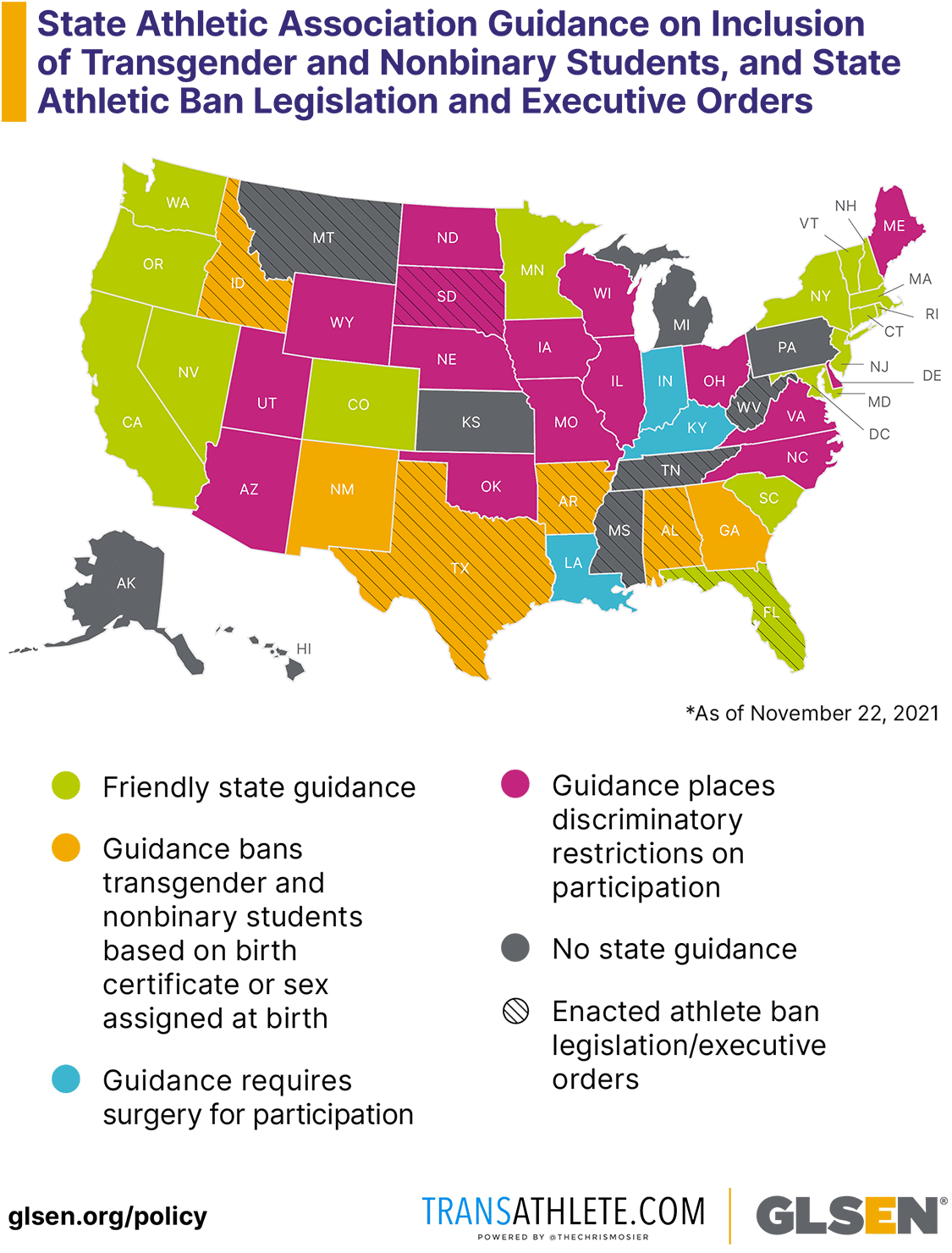Gender Affirming and Inclusive Athletics Participation
GENDER AFFIRMING AND INCLUSIVE ATHLETICS PARTICIPATION
For all students, having the opportunity to participate in sports results in positive outcomes, including physical development,1 social skills,2 and psychological well-being. The psychological benefits of sports specifically include improved emotional regulation,3 decreased hopelessness and suicidality,4 fewer depressive symptoms,5 and higher self-esteem.6 Research has also found that sports participation is related to greater feelings of school belonging and pro-school behaviors.7 Among LGBTQ youth specifically, research has found psychological well-being and school belonging benefits of sports participation.8 GLSEN’s research has shown that on a 4.0 scale, LGBTQ+ student athletes have a GPA that is 0.2 points higher than students who did not participate in athletics.9 LGTBQ+ team leaders have a GPA that is 0.4 points higher than their peers who did not participate in athletics. Further, 56% of LGBTQ+ team members and 66% of LGBTQ+ team leaders competing in high school sports report feeling a positive sense of belonging at school.10
Every student should have equal opportunity in education where they can thrive and reach their full potential. Transgender (trans) and nonbinary students should have the same access to athletic participation as their classmates. Unfortunately, many trans and nonbinary students face barriers to participating in sports. In a 2019 survey, only 12.5% of trans and nonbinary students reported that their school had policies or guidelines to support trans and nonbinary students.11 Among trans and nonbinary students who reported their school had policies or guidelines to support trans and nonbinary students, only 41.7% reported that their school policy addressed inclusive participation in athletics.12 In some instances, students had to use a locker room that was inconsistent with their gender identity that did not reflect their gender.13 Additionally, 44.5% of transgender students and 36.3% of nonbinary students reported being prevented from using their chosen name and pronouns.14 These discriminatory practices prevent trans and nonbinary students from participating in K-12 learning communities as fully as their cisgender peers.15
State Athletic Association Guidance and Trans Athletic Ban Legislation
State athletic association guidance is often the mechanism by which states establish standards for trans and nonbinary student participation in athletics. These standards vary significantly from state to state, with some state policies encouraging full participation and others creating discriminatory barriers. In addition, state legislators across the country have decided to champion and pass discriminatory legislation barring gender-affirming participation of transgender student athletes, and only allow students to compete on teams based on their sex assigned at birth as indicated on a student’s original birth certificate or by an invasive medical examination from a healthcare provider. This began with HB 500 in Idaho in 2020, and since then a rash of similar bills have been introduced in more than 30 states, with legislation being enacted in Arizona, Arkansas, Alabama, Florida, Kentucky, Mississippi, Montana, Oklahoma, South Dakota, Tennessee, Texas, Utah, and West Virginia. These laws are currently being challenged in a number of law suits.
In other states with discriminatory state athletic association guidance, such as Utah and South Dakota, athletic associations require undue and invasive “proof” that consists of confidential medical information that must be provided before a school allows a student to participate. Some of these standards list requirements such as documentation of surgery, hormone reports, or other sensitive medical information.
Conversely, in states with affirmative and inclusive guidance, students are given the opportunity to participate in ways that affirm their gender identity, even when that may not be consistent with a gender marker on their birth certificate or listed in school records. If their participation is questioned, some state guidance outlines procedures on how to address concerns, while maintaining the safety and privacy of the student in question. Lastly, some states, such as Alaska and Kansas, lack statewide guidance, which leaves decisions about inclusion of trans and nonbinary students to individual schools.


GLSEN has partnered with TransAthlete to create a visual representation of the type of laws and athletic association guidance on inclusion of transgender and nonbinary student athletes that each state has in place. This policy map shows that there are 17 states (including D.C) that have friendly policies that help facilitate full inclusion of trans and nonbinary students in high school athletics. There are 6 states with guidance that excludes trans and nonbinary students by requiring students to participate in athletics based on their birth certificate or their sex assigned at birth. Another 3 states bar trans and nonbinary students from participation unless they have undergone surgery. Discriminatory restriction policies that create additional barriers to inclusion of trans and nonbinary students are in place in 16 states. Finally, there are 10 states that have not issued any statewide guidance.
State Highlight: Oregon
The Oregon School Activities Association (OSAA) issued guidance on the inclusion of trans and nonbinary student inclusion in K-12 athletics that affirms and supports their participation. These guidelines were developed in alignment with Oregon state nondiscrimination laws in public education (ORS 174.100). The OSAA Handbook16 policy states that students may participate in athletics that align with their gender identity, regardless of the gender marker listed on their birth certificate. The policy further clarifies and provides guidelines for participation of nonbinary students. Oregon’s policy prioritizes privacy and communication with trans and nonbinary students and ensures there is clear guidance for local education agencies and schools.
Recommendations for Inclusive Athletics Guidance
To ensure fairness and equality in athletic participation for all students, state athletic associations should develop guidance for local education agencies and schools that affirms and supports the right of trans and nonbinary students to participate in interscholastic and intramural sports. State athletic association guidance should include the following components that were adopted from existing guidance and resources:
- A student has the right to participate in athletics in a manner consistent with their gender identity, even if that identity differs from the sex listed on a student’s registration records or birth certificate.
- Where a student athlete has a transgender or nonbinary identity, [the association or school] will work in partnership with them to ensure participation and facility usage that is affirming and safe.
- Transgender and nonbinary student athletes can use the locker room, shower, and restroom facilities in accordance with their gender identity, or where they feel safest. Locker rooms and shower facilities will include private enclosed changing areas for use by any student who desires such privacy.
- Transgender and nonbinary student athletes may use a common name or gender pronouns that are inconsistent with school records or identity documents. Coaches, administrators, and officials will make every reasonable effort to honor a student’s common use name and gender pronouns, and ensure that those are honored by teammates, opponents, fans, volunteers, announcers, etc.
- If there is a petition challenging a student’s participation in a gender-segregated activity consistent with their gender identity, [the school or athletic association] will assemble an eligibility committee, which will include school administrators, staff members, experts in health, including transgender health and wellness, and/or gender-affirming advocates familiar with the issues affecting LGBTQ+ youth.
- In the case of an appeal, an athletic association or eligibility committee can review, but not require documentation of a student’s consistent gender identity, including written statements from the student, parent/guardian, and/or health care provider.
- A student’s gender identity, gender affirming health related documentation, and other highly personal information, if consensually disclosed, will be kept confidential to [the school administrators or associations] in question. Where students or teams are competing against other schools, staff, athletic directors, and/or coaches should communicate with their counterparts, without violating the student’s confidentiality. Athletic staff and/or coaches should clearly communicate with the student athlete in question, and seek their feedback about what information can be presented in communication with other schools/teams. These discussions can include expectations for treatment including the use of locker/shower facilities, names, pronouns, etc.
Additional Resources
- TransAthlete: www.transathlete.com
- Athlete Ally: www.athleteally.org
- Fair Play: The Importance of Sports Participation for Transgender Youth (Center for American Progress)
- Play to Win: Improving the Lives of LGBTQ Youth in Sports (Human Rights Campaign)
-----------------------------------
1 Biddle, S. J. H, & Asare, M. (2011). Physical activity and mental health in children and adolescents: A review of reviews. British Journal of Sports Medicine, 45(11), 886-895; Snyder, A., Martinez, J., Bay, R., Parsons, J., Sauers, E., & McLeod, T. (2010). Health-related quality of life differs between adolescent athletes and adolescents nonathletes. Journal of Sport Rehabilitation, 19, 237-248.
2 Bailey, R. (2006). Physical education and sport in schools: A Review of benefits and outcomes. Journal of School Health, 76(8), 397-401; Eime, R. M., Young, J. A., Harvey, J. T., Charity, M. J., & Payne, W. R. (2013). A systematic review of the psychological and social benefits of participation in sport for children and adolescents: Informing development of a conceptual model of health through sport. International Journal of Behavioral Nutrition and Physical Activity, 10(98).
3 Eime, R. M., et al (2013); Hansen, D. M., Larson, R. W., & Dworkin, J. B. (2003). What adolescents learn in organized youth activities: A survey of self-reported developmental experiences. Journal of Research on Adolescence, 13(1), 25-55.
4 Taliaferro, L. A., Rienzo, B. A., Pigg, R. M., Miller, M. D., & Dodd, V. J. (2009). Associations between physical activity and reduced rates of hopelessness, depression, and suicidal behavior among college students. Journal of American College Health, 57(4), 427-436; Taliaferro, L. A., Eisenberg, M. E., Johnson, K. E., Nelson, T. F., Neumark-Sztainer, D. (2011). Sport participation during adolescence and suicide ideation and attempts. International Journal of Adolescent Medicine and Health, 23 (1), 3-10.
5 Boone, E., & Leadbeater, B. (2006). Game on: Diminishing risks for depressive symptoms in early adolescence through positive involvement in team sports. Journal of Research on Adolescence, 16(1), 79-90; Eime, R. M., et al (2013).
6 Adachi, P. J. C., & Willoughby, T. (2014). It’s not how much you play, but how much you enjoy the game: The longitudinal associations between adolescents’ self-esteem and the frequency versus enjoyment of involvement in sports. Journal of Youth and Adolescence, 43(1), 137-145; Bailey, R. (2006); Eime, R. M., et al (2013); Slutzky, C. B., & Simpkins, S. D. (2009). The link between children’s sport participation and self-esteem: Exploring the mediating role of sport self-concept. Psychology of Sport and Exercise, 10(3), 381-389.
7 Clark, C. M. & Kosciw, J. G. (2021). Engaged or excluded: LGBTQ youth’s participation in school sports and their relationship to psychological well-being. Psychology in the Schools. https://doi.org/10.1002/pits.22500
8 Ibid.
9 GLSEN (2013). The Experiences of LGBT Students in School Athletics (Research Brief). New York: GLSEN. Available at, https://www.glsen.org/sites/default/files/2020-06/The%20Experiences%20of%20LGBT%20Students%20in%20Athletics.pdf.
10 Ibid.
11 Kosciw, J. G., Clark, C. M., Truong, N. L., & Zongrone, A. D., (2020). “The 2019 National School Climate Survey: The experiences of lesbian, gay, bisexual, transgender, and queer youth in our nation’s schools.” New York: GLSEN, 66. Available at https://www.glsen.org/research/2019-national-school-climate-survey.
12 Ibid.
13 Ibid. at 100.
14 Ibid.
15 Goldberg, S.K. (2021) Fair Play: The Importance of Sports Participation for Transgender Youth. Center for American Progress. Available at https://www.americanprogress.org/issues/lgbtq-rights/reports/2021/02/08/495502/fair-play/; see also, Johnson, A., Miranda, L., & Lee, M. (2021). Play to Win: Improving the Lives of LGBTQ Youth in Sports. Human Rights Campaign. Available at: https://assets2.hrc.org/files/assets/resources/PlayToWin-FINAL.pdf.
16 Oregon School Activities Association. 2020-2021 Handbook. Available at: https://www.osaa.org/docs/handbooks/osaahandbook.pdf.
